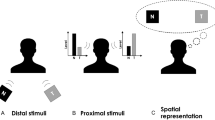Abstract
The authors studied fused auditory image (FAI) movement trajectories under conditions of direct nonsimultaneous masking. This movement was created by a gradual change in a dichotically presented series of clicks with interaural differences in stimulation from 0 to ±700 μs or from ±700 to 0 μs. Binaurally presented transmissions of wide-band noise served as maskers. The location and length of the trajectories were evaluated without a masker and with five values of the time lag between the signal beginning and masker end. When the test signal duration was 200 ms, the length of the trajectories was 33–44° without a masker. In the first test group, this trajectory lay close to the median line of the head without a masker (irrespective of the movement direction) and moved away from it under masking conditions. When the FAI moved from the median line towards the right or left ear, the initial part of the trajectory was masked; when the movement direction was opposite, the final part was masked. In the second group, the trajectories were located near the ears when the FAI moved from either ear and shifted towards the median line as a result of masking. When the movement direction was opposite, they were close to the median line and shifted towards the ear under masking conditions. When the FAI moved along all trajectories, their initial parts were masked.
Similar content being viewed by others
REFERENCES
Bibikov, N.G., Masing, in Slukhovaya sistema (Auditory System), Leningrad: Nauka, 1990, p. 69.
Kolrausch, A. and Fassel, R., Binaural Masking Level Differences in Nonsimultaneous Masking, in Binaural and Spatial Hearing in Real and Virtual Environments, New Jersey, 1997, p. 169.
Al'tman, Ya.A. and Ogorodnikova, E.A., Binaural Unmasking with Nonsimultaneous Presentation of Masker and Signal, Sensor. Sist., 1991, vol. 5, no. 2, p. 50.
Al'tman, Ya.A., Lokalizatsiya dvizhushchegosya istochnika zvuka (Localization of Moving Sound Source), Leningrad: Nauka, 1983.
Petropavlovskaya, E.A., Study of Direct Nonsimultaneous Masking of Moving and Immobile Auditory Images in Humans, Sensor. Sist., 2001, vol. 15, no. 4, p. 301.
Dobrokhotova, T.A. and Bragina, N.N., Levshi (Lefthanders), Moscow: Kniga, 1994.
Al'tman, Ya.A., Rozenblyum, A.S., and L'vova, V.G., Perception of a Moving Subjective Auditory Image by Patients with Affected Temporal Lobe, Fiziol. Chel., 1979, vol. 5, no. 1, p. 55.
Al'tman, Ya.A., Balonov, L.Ya., Deglin, V.L., and Menshutkin, V.V., The Role of the Dominant and Nondominant Hemisphere in the Spatial Hearing Organization, Fiziol. Chel., 1981, vol. 7, no. 1, p. 12.
Varyagina, O.V., Human Evaluation of the Initial Point of the Auditory Image Movement Trajectory, Sensor. Sist., 2001, vol. 15, no. 4, p. 324.
Al'tman, Ya.A., Varyagina, O.V., and Radionova, E.A., Manifestations of Functional Asymmetry of the Brain in Lateralization of a Moving Continuous Auditory Image, Fiziol. Chel., 1998, vol. 24, no. 5, p. 48.
Altman, Ya.A., Varyagina, O.V., Nikitin, N.I., and Radionova, E.A., Lateralization of a Moving Auditory Image: Interaction of Interaural Time and Intensity Differences, J. Acoust. Soc. Am., 1999, vol. 105, no. 1, p. 366.
Solov'eva, A.I., Osnovy psikhologii slukha (Fundamentals of Hearing Psychology), Leningrad: LGU, 1972.
Litovsky, R.Y., Colburn, H.S., Yost, W.A., and Guzman, S.J., The Precedence Effect, J. Acoust. Soc. Am., 1999, vol. 106, no. 1, part 4, p. 1633.
Burke, K.A., Letsos, A., and Butler, R.A., Asymmetric Preformances in Binaural Localization of Sound in Space, Neuropsychology, 1994, vol. 32, no. 11, p. 1409.
Butler, R.A., Asymmetric Preformances of Sound in Space, Neuropsychology, 1994, vol. 32, no. 2, p. 221.
Al'tman, Ya.A., Radionova, E.A., Varyagina, O.V., and Nikitin, N.I., Psychophysiological Features of Lateralization Effect in the Perception of a Moving Continuous Auditory Image, Fiziol. Chel., 1997, vol. 23, no. 2, p. 80.
Varyagina, O.V. and Radionova, E.A., Manifestation of Functional Asymmetry of the Brain in the Auditory Image Lateralization, Fiziol. Chel., 1998, vol. 24, no. 2, p. 40.
Author information
Authors and Affiliations
Rights and permissions
About this article
Cite this article
Petropavlovskaya, E.A., Al'tman, Y.A. Change in Auditory Image Movement Trajectories under Conditions of Direct Nonsimultaneous Masking. Human Physiology 28, 540–548 (2002). https://doi.org/10.1023/A:1020270617023
Issue Date:
DOI: https://doi.org/10.1023/A:1020270617023



